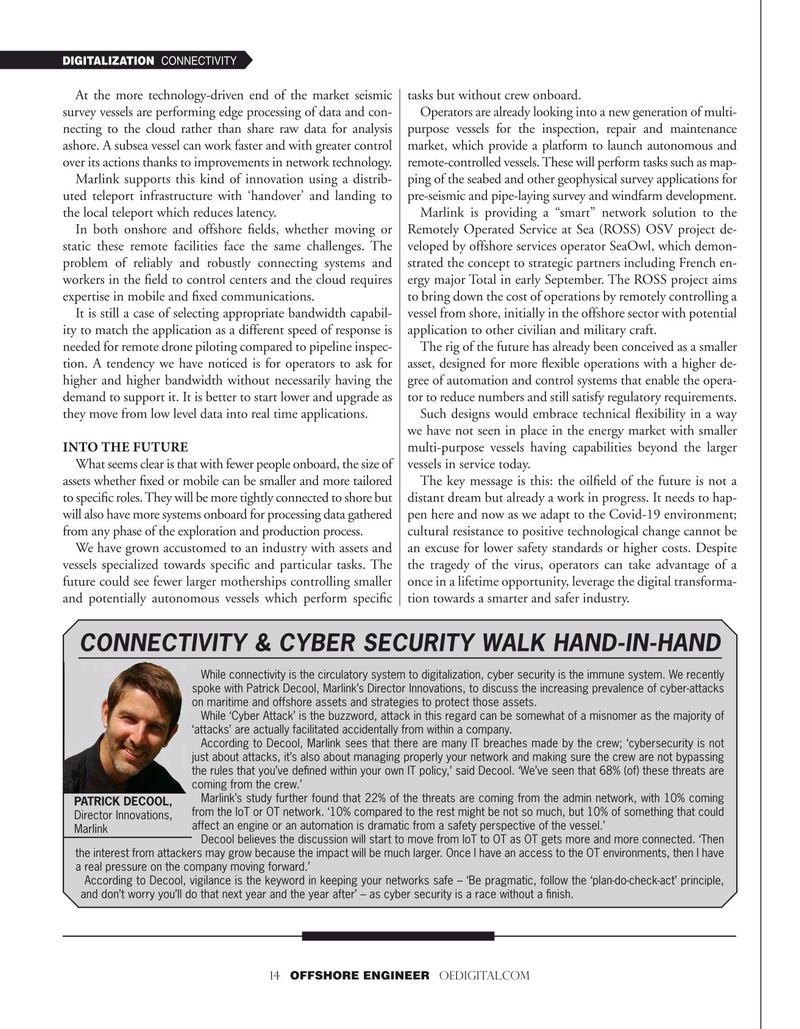
Page 14: of Offshore Engineer Magazine (Nov/Dec 2020)
Read this page in Pdf, Flash or Html5 edition of Nov/Dec 2020 Offshore Engineer Magazine
DIGITALIZATION CONNECTIVITY
At the more technology-driven end of the market seismic tasks but without crew onboard. survey vessels are performing edge processing of data and con- Operators are already looking into a new generation of multi- necting to the cloud rather than share raw data for analysis purpose vessels for the inspection, repair and maintenance ashore. A subsea vessel can work faster and with greater control market, which provide a platform to launch autonomous and over its actions thanks to improvements in network technology. remote-controlled vessels. These will perform tasks such as map-
Marlink supports this kind of innovation using a distrib- ping of the seabed and other geophysical survey applications for uted teleport infrastructure with ‘handover’ and landing to pre-seismic and pipe-laying survey and windfarm development.
the local teleport which reduces latency. Marlink is providing a “smart” network solution to the
In both onshore and offshore ?elds, whether moving or Remotely Operated Service at Sea (ROSS) OSV project de- static these remote facilities face the same challenges. The veloped by offshore services operator SeaOwl, which demon- problem of reliably and robustly connecting systems and strated the concept to strategic partners including French en- workers in the ?eld to control centers and the cloud requires ergy major Total in early September. The ROSS project aims expertise in mobile and ?xed communications. to bring down the cost of operations by remotely controlling a
It is still a case of selecting appropriate bandwidth capabil- vessel from shore, initially in the offshore sector with potential ity to match the application as a different speed of response is application to other civilian and military craft.
needed for remote drone piloting compared to pipeline inspec- The rig of the future has already been conceived as a smaller tion. A tendency we have noticed is for operators to ask for asset, designed for more ?exible operations with a higher de- higher and higher bandwidth without necessarily having the gree of automation and control systems that enable the opera- demand to support it. It is better to start lower and upgrade as tor to reduce numbers and still satisfy regulatory requirements.
they move from low level data into real time applications. Such designs would embrace technical ?exibility in a way we have not seen in place in the energy market with smaller
INTO THE FUTURE multi-purpose vessels having capabilities beyond the larger
What seems clear is that with fewer people onboard, the size of vessels in service today. assets whether ?xed or mobile can be smaller and more tailored The key message is this: the oil?eld of the future is not a to speci?c roles. They will be more tightly connected to shore but distant dream but already a work in progress. It needs to hap- will also have more systems onboard for processing data gathered pen here and now as we adapt to the Covid-19 environment; from any phase of the exploration and production process. cultural resistance to positive technological change cannot be
We have grown accustomed to an industry with assets and an excuse for lower safety standards or higher costs. Despite vessels specialized towards speci?c and particular tasks. The the tragedy of the virus, operators can take advantage of a future could see fewer larger motherships controlling smaller once in a lifetime opportunity, leverage the digital transforma- and potentially autonomous vessels which perform speci?c tion towards a smarter and safer industry.
CONNECTIVITY & CYBER SECURITY WALK HAND-IN-HAND
While connectivity is the circulatory system to digitalization, cyber security is the immune system. We recently spoke with Patrick Decool, Marlink’s Director Innovations, to discuss the increasing prevalence of cyber-attacks on maritime and offshore assets and strategies to protect those assets.
While ‘Cyber Attack’ is the buzzword, attack in this regard can be somewhat of a misnomer as the majority of ‘attacks’ are actually facilitated accidentally from within a company.
According to Decool, Marlink sees that there are many IT breaches made by the crew; ‘cybersecurity is not just about attacks, it’s also about managing properly your network and making sure the crew are not bypassing the rules that you’ve de?ned within your own IT policy,’ said Decool. ‘We’ve seen that 68% (of) these threats are coming from the crew.’
Marlink’s study further found that 22% of the threats are coming from the admin network, with 10% coming
PATRICK DECOOL, from the IoT or OT network. ‘10% compared to the rest might be not so much, but 10% of something that could
Director Innovations, affect an engine or an automation is dramatic from a safety perspective of the vessel.’
Marlink
Decool believes the discussion will start to move from IoT to OT as OT gets more and more connected. ‘Then the interest from attackers may grow because the impact will be much larger. Once I have an access to the OT environments, then I have a real pressure on the company moving forward.’
According to Decool, vigilance is the keyword in keeping your networks safe – ‘Be pragmatic, follow the ‘plan-do-check-act’ principle, and don’t worry you’ll do that next year and the year after’ – as cyber security is a race without a ?nish.
14 OFFSHORE ENGINEER OEDIGITAL.COM

 13
13

 15
15